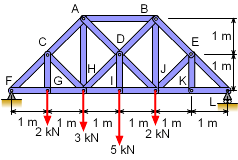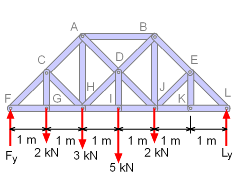| Ch 6. Structures | Multimedia Engineering Statics | ||||||
| 2-D Trusses: Joints | 2-D Trusses: Sections | 3-D Trusses | Frames and Machines | ||||
| 2-D Trusses: Method of Sections | Case Intro | Theory | Case Solution | Example |
| Chapter |
| 1. Basics |
| 2. Vectors |
| 3. Forces |
| 4. Moments |
| 5. Rigid Bodies |
| 6. Structures |
| 7. Centroids/Inertia |
| 8. Internal Loads |
| 9. Friction |
| 10. Work & Energy |
| Appendix |
| Basic Math |
| Units |
| Sections |
| eBooks |
| Dynamics |
| Fluids |
| Math |
| Mechanics |
| Statics |
| Thermodynamics |
| ©Kurt Gramoll |
|
|
||
| Example |
||
 Complex Truss with Loading |
Determine the force in members BE, BJ, DJ, and IJ. (ADJ and HDB are not continues, each consist of two elements.) |
|
| Solution |
||
 Reaction Forces at End Supports |
The first step is to find the support reaction forces. Vertical reaction force at F can be found by taking the moment about L. ΣML= 0 Fy = 6.833 kN Summation of forces in the y direction should be zero. ΣF= 0 Another method to find Ly is to take the moment about F. It is a good way to check to see if the previous value for Ly was found correctly. ΣMF = 0 Ly = 5.167 kN |
|
 Method of Section (Cut 1) to Determine FBE |
To find the value of the forces it is easier to use method of sections. Since the problem asks for four member forces, BE, BJ, DJ, and IJ, the problem needs to be solved taking two cuts. The first cut , shown at the left, will be used to solve for member force in member BE. Then another cut will be used to find the other three member forces. Moments about J can be taken to find the value of the FBE (notation EJ represents the length of the member EJ). ΣMJ = 0 JBE is a right triangle and BE is perpendicular to EJ. The length of KE and JK is 1. Based on Pythagorean theorem, EJ is the square root of 2. (EJ = 1.414). 2L + FBE(1.414) = 0 |
|
|
Now that FBE is known, another cut can be made to find FJB, FJD, and FIJ. To find FJD and FJB, moment about L can be used with the sum of the vertical forces (notation JL mean length of JL) ΣML = 0 ΣFy = 0 FJD and FJB can be found by solving the above system of equations to give FJD = -0.8327(10-3) kN (very small) FJB = 2.000 kN FJD is found to be 0.8 newton which is negligible and is because of the rounding errors. Summation of forces in x direction can be written in order to find the value of FIJ ΣFx = 0 FIJ = 5.167 kN FIJ can also be found by taking the moment about joint B ΣMB = 0 FIJ = 5.167 kN |
|
Practice Homework and Test problems now available in the 'Eng Statics' mobile app
Includes over 500 free problems with complete detailed solutions.
Available at the Google Play Store and Apple App Store.
